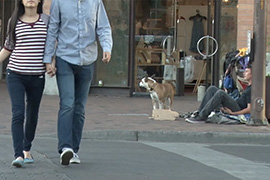- Slug: BC-CNS-Homeless Helpers,640
- File photo available (thumbnail, caption below)
By DUSTIN QUIROZ
Cronkite News
WASHINGTON – Religion scholar Byron Johnson is one of those people who “always has their ear to the ground” for news of faith and society, but even he was surprised by his study on homelessness and faith-based organizations.
Johnson’s study of 11 cities, including Phoenix, found that faith-based groups had provided nearly 60 percent of emergency shelter beds in those cities over the past two years.
While Phoenix fell short of the average, with faith-based organizations accounting for 41 percent of the city’s emergency shelter beds, those groups still play a “significant role in addressing homelessness,” said a regional official with the Department of Housing and Urban Development.
Ed Cabrera, a spokesman for HUD region 9, said collaboration between the faith groups and local and federal governments helped spark improvements in the homeless picture in Phoenix. That, in turn, opened the door to a $25 million grant to the Valley’s Continuum of Care program for its efforts fighting homelessness in recent years.
“They (faith-based groups) increased their coordination outside of their organization or sector, they’re working more hand-in-glove with HUD and the continuum of care,” Cabrera said, describing the program in which organizations work with the government to reduce homelessness.
An official with the Phoenix Rescue Mission said that groups like hers can bridge the gap between the government and the community, working and getting help from both sides.
“We have become more of an impact in our cities and our counties because the people are supporting us and we’re not reliant on if we’re going to get funding or not,” said Nicole Pena, director of public affairs for the Phoenix Rescue Mission.
The collaboration between public and private organizations also helps get the right type of help to the right people, Pena said.
“In Phoenix, we have a variety of places where people and the partners are all working together so we can refer people to the right solution,” she said.
Pena said faith groups bring one more thing to the table: Unlike government or secular groups, they can sometimes reach out and offer more that “just a shelter” to people who were raised in religious homes.
Cabrera echoed that sentiment.
“One opportunity that faith-based communities have is delivering something that, frankly, government-funded programs have had a difficult time delivering,” he said. “And that’s this larger issue of not just providing a home and not just services, but that sense of community.”
But Cabrera also gave credit to the city and to Mayor Greg Stanton’s push to end chronic homelessness there. That includes efforts to strengthen documentation of the homeless population, which allowed the city to identify and address many of these issues, he said.
Officials with government, secular and faith-based groups said the current partnership is paying off. In spite of the gains, however, both Cabrera and Pena understand that there are problems yet to be resolved.
One area highlighted in the report was the problem of veteran homelessness.
Recent vets are “faced with similar, if not greater, challenges” than veterans from previous wars, Cabrera said. They are “less likely to return with strong family and community ties” as they struggle to deal with the psychological repercussions of combat.
“We have seen much progress,” Cabrera said. “But we still have much to do.”
Johnson, a professor at Baylor University’s Institute for Studies of Religion, who released the report recently, agreed that work needs to be done, and expressed the importance of tackling homelessness in a collaborative effort – one of the reasons he did the study, he said.
“That’s why the research was necessary,” Johnson said. “To get skeptics and people who are agnostic and people that are faithful, all of them and have them take a look at this issue and see what we might be able to do better than what we are doing now.”
^__=
Web links:
_ Baylor report: http://www.baylorisr.org/wp-content/uploads/ISR-Homeless-FINAL-01092017-web.pdf
_ HUD award: https://www.azmag.gov/Administration/News.asp?y=2016&i=4540
_ Continuum of Care: https://www.hudexchange.info/programs/coc/
^__=
A recent report says 41 percent of the emergency shelter beds for Phoenix homeless, like the youth here, were supported by faith-based groups. That was below the 60 percent average in 11 large cities studied, but still enough to help dent the problem. (Photo by Sabella Scalise/Cronkite News)
